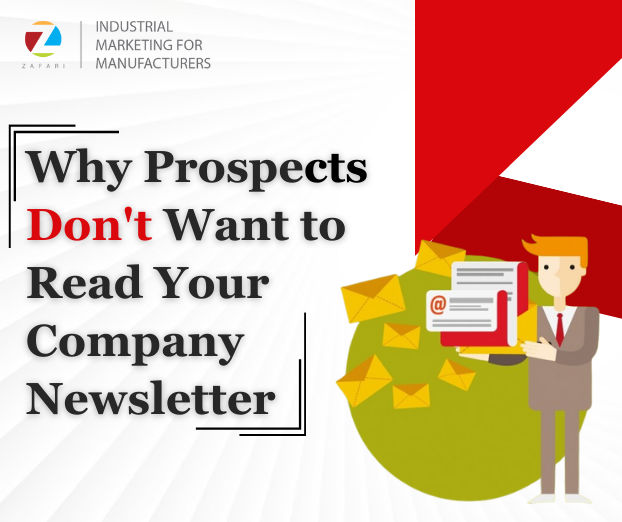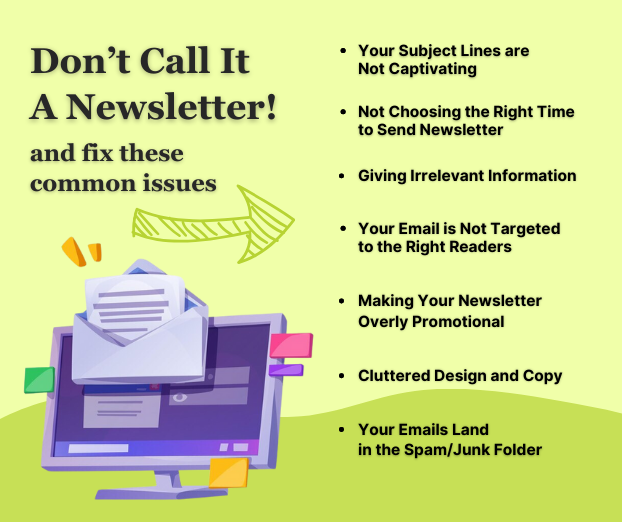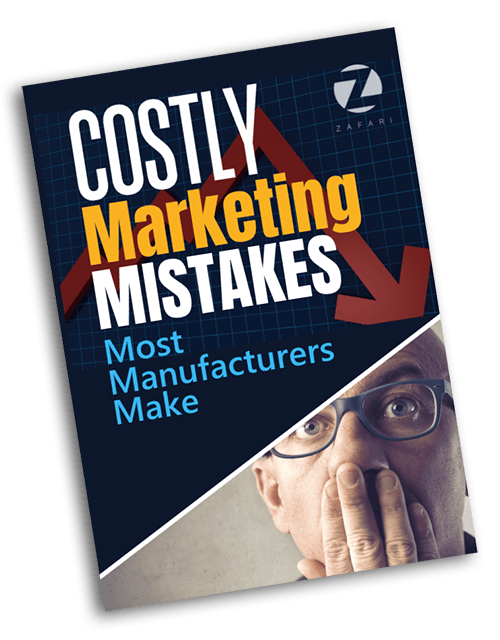Email newsletters have been an important part of B2B marketing, with 73% of B2B marketers using them for their content marketing strategy.
However many marketers must admit that newsletters actually help them gain new customers or sell more products or services.
Often, their prospects don’t even open their company newsletter.

Why does this happen?
Well, there could be a bunch of mistakes you’re making with your newsletter that are stopping people from opening it or engaging with the content.
In this article, we’ll talk about why your prospects might not want to read your company newsletter and what you should do about it.
Don’t Call It A Newsletter!
How excited are you to read someone’s newsletter? The term brings up bland, irrelevant and self-focused company happenings that are much more interesting to the people who work for the company than a prospective or existing customer.
Instead of offering a newsletter, come up with a catchy, memorable name that’s relevant to your audience and their problems.
Be sure to use this catchy title and a clear explanation of what the reader can expect to gain from reading on your signup forms!

Your Subject Lines are Not Captivating:
Subject lines or email titles are small but powerful. They can convince someone to open your message even with a few words.
35% of people open emails just because of the subject lines, even if they haven’t gone through your emails before or know who you are.
If you check your inbox, you’ll see lots of different email titles. Some are long, some are short, and some have emoji while others don’t.
Most manufacturing marketers believe that their subject lines should be product-focused, clever or mysterious, but actually, the best lines are usually clear and straightforward.
Effective subject lines jump out in an inbox full of hundreds of generic or off-the-mark bids for your reader’s attention. They do this by being:
- Short
- Personalized
- Unexpected
- Conversational
- Focused on the customer’s pain points
- Relevant – asking a question to stir your reader’s curiousity
Here are a few examples:
- New Product Launch: Risking your reputation with unreliable gas connectors? Not anymore!
- Case Study Revealed: XYZ Company Boosted ROI by 30%. You can too.
- Limited-Time Demo Access: Hey Sam, if you’ve got gas hoses you need to see this
- Weekly Digest: What’s Hot Right Now in Industrial Automation
- You’re Invited: Come Meet Your Next Strategic Partner
- Exclusive Whitepaper: Find Out How XYZ Increased Operation Efficiency by 45%
Make sure you don’t promise something exciting in your subject line and then give something different in your email.
Also be sure to optimize your pre-header text appearing next to the subject line in the inbox. Pre-headers are a great place to add a little more oomph to increase the curiosity among your potential readers.
Not Choosing the Right Time to Send Newsletter:
When is the right time to send your newsletter?
It may be different for everyone.
What might work for one newsletter might not be ideal for your subscribers, especially if they live in different time zones. On top of that, asking different marketers leads to different answers.
Therefore, consider factors like time zones, workdays, demographics, etc. This will give you an idea about the right time to send your emails.
According the several studies and industry professionals, Mondays and Tuesdays are ideal for B2Bs. Sending emails during off-hours, weekends, or holidays is not recommended. Again, the right time to send your emails depends on time zones, demographics, and workdays.
In this scenario, A/B testing can help you in determining what can work best for you. In A/B testing, you send two versions of an email at different times to different segments to see which one works better.
Tools like ActiveCampaign can help streamline this experimentation process, allowing you to optimize your email marketing campaigns effectively. They also offer functionality such as ‘predictive sending’ that decides based on historical data the optimal time to send to each subscriber.
Giving Irrelevant Information:
Not delivering what you promise is an easy way to lose your customers. The same applies to email marketing.
Imagine you’ve assured your readers of insightful industry updates and trends through your newsletter. This has caused them to subscribe to your newsletter, trusting what you say. However, upon opening the email, they found nothing but employee news, promotional offers or links asking them to take some action.
This breach can shatter their trust and cause unsubscribes. It is somewhat like promising a nourishing meal and serving junkfood instead. You’ve got the precious attention of your customers, don’t waste it!
Your Email is Not Targeted to Right Readers:
Not having an ideal potential or target audience on your email list is another reason why your emails go unnoticed.
You are a car tire manufacturer, but your email is being delivered to a random set of people across many unrelated industries. This not only wastes your valuable marketing efforts, but harms your sending reputation since you’ll get more unsubscribes and spam complaints.
When we optimized some of our B2B clients’ email campaigns, we found that nearly one-fourth of their subscribers were their friends, families or general B2C customers.
If you want your emails to make an impact, make sure they’re reaching the right people—the ones who are genuinely interested in what you offer.
Start by clearly defining who your ideal readers are. Consider factors such as demographics (age, gender, location, and occupation), interests, and pain points. Understanding your audience will help you tailor your content to their needs and preferences.
Making Your Newsletter Overly Promotional:
Sure. You want to market your products through email marketing. But screaming “buy, buy, and buy” throughout your content might annoy the customers.
Your subscribers probably don’t want emails all about buying your products. They might get tired of it and stop paying attention.
Balance your sale portion with some guidance or educational content.
For example, you’re looking for a CNC router foam-cutting machine, and you signed up for emails from a company. But instead of helpful info, they keep sending you emails every day just asking you to buy. It’s annoying, right? If they send you useful content, like tips on choosing the right machine or how to take care of it, you might actually want to read their emails again.
So, when you send newsletters, don’t make it overly promotional. The rule of thumb is 90% helpful, 10% promotional. Instead, focus on giving your readers valuable information that helps them solve a problem. Only mention your products or services when you have something really exciting to share.
Cluttered Design and Copy:
A newsletter can easily get cluttered with a lot of information and visuals, particularly when you’re sharing products. However, it is important to keep things simple and clean.
To do this, use short and clear copy. In our text and Twitter age, no one will actually take the time to read paragraph text. Instead, give them bullets, infographics and visuals to convey your message. If you must include paragraph text, highlight or bold important keywords you want to make sure they notice.
This makes your newsletter look less crowded and helps people on mobile devices tap the right links more easily.
Your Emails Land in the Spam Folder:
Even if you have the best email in the world, it might end up in the spam folder. Thanks to certain words and phrases that can trigger spam filters such as “limited offer” and “order now”.
Here are some words to avoid:
– Act now
– Clearance
– Important information regarding
– Offer expires
– Satisfaction guaranteed
– Visit our website
– No strings attached
– You are a winner!
To check if your newsletter might be flagged as spam, you can use a free tool called Mail Tester. Just send your test newsletter to their address, and they’ll run a test on it. They’ll give you a score and a report showing what you can do to fix any issues.
ON A FINAL NOTE…
If you keep these things in mind, your newsletters will be interesting and people will want to read them. Your newsletter can help you get more customers, make your brand stronger, and share useful info with your community. It can be one of your most important marketing assets.
Start by knowing who your audience is. Focus on helping them, not just talking about yourself. Remember that the people who signed up to get your emails are important, and keep them in mind when creating a newsletter. Best of luck!


